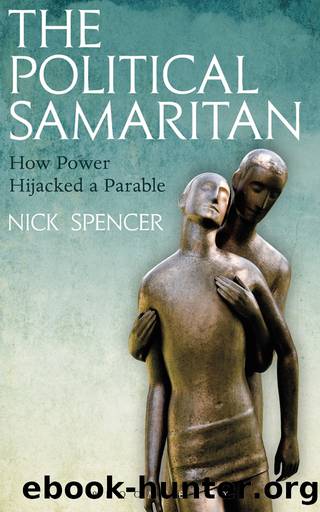The Political Samaritan by Nick Spencer

Author:Nick Spencer
Language: eng
Format: epub
Publisher: Bloomsbury Publishing
A PRIEST AND A LEVITE WERE WALKING ALONG A ROAD . . .
These matters of life, death and ritual purity, although important to all first-century Jews, were especially so among their priests. And so it is that, the crime committed, the anonymous man left naked and half-dead, it is a priest who happens to be going down the same dangerous road in the same dangerous territory.
In one sense, the entire nation of Israel was intended to be a kingdom of priests, as God tells Moses to tell his people after the Exodus: âout of all nations you will be my treasured possession . . . you will be for me a kingdom of priests and a holy nationâ.42 This implied certain responsibilities for all the people but, in reality, there was, from the earliest days of the nation, a particular class that was charged with representing the people before God and God before the people.
Priests did this through various means. They practised âoracular divinationâ, that is finding out what God wanted, in earlier ages, although there is no evidence of this being done in Jesusâ time.43 They instructed the people in the law.44 But their main focus was on the cultic life of the tabernacle, then the Temple and the performance of certain, carefully prescribed ritual duties. They inspected for signs of disease, conducted purification rights, pronounced blessings, fixed sacrificial limits for worshippers according to their ability to pay, collected tithes and maintained the Temple treasury, policed the boundaries of the Temple area and, relevantly, evaluated problems resulting from contact with dead bodies.
The priestly upper classes were deported by the Assyrians and Babylonians when they conquered the northern and southern kingdoms of Israel in the eighth and sixth centuries BC, respectively,45 but, after returning from exile, they played a lead role in re-organising the Temple, which received a growing flow of tithes that further added to the priestsâ importance. The zenith of their authority came in the second century BC, in which Israelâs independence was asserted against occupying forces, and at least one ruler, John Hyrcanus, 135â104 BC, combined kingship and priesthood. By the time of Herod the Great, however, the priesthood, and even the Jerusalem high priesthood, had lost much of its power, with the quisling king Herod appointing high priests.
By Jesusâ time, a significant social gap had opened between chief priests and ordinary ones. The former were high status, aristocratic, sanctified and viewed as the highest representative of the people themselves.46 They actively worked with Romans in maintaining as much peace in the province as was possible in the circumstances. The latter were rather less compliant, on every account.
Not necessarily rich, or upper class, ordinary priests inherited their rank through the patrilineal line, and formed 24 divisions of service through family groups, divisions of which performed service in the Jerusalem Temple twice each year for one week. During that week, they performed the full range of ritual activities, although they divided by lot the greatest honour: of entering
Download
This site does not store any files on its server. We only index and link to content provided by other sites. Please contact the content providers to delete copyright contents if any and email us, we'll remove relevant links or contents immediately.
The Lost Art of Listening by Michael P. Nichols(7411)
Why I Am Not A Calvinist by Dr. Peter S. Ruckman(4103)
The Rosicrucians by Christopher McIntosh(3467)
Wicca: a guide for the solitary practitioner by Scott Cunningham(3127)
Signature in the Cell: DNA and the Evidence for Intelligent Design by Stephen C. Meyer(3075)
Real Sex by Lauren F. Winner(2968)
The Holy Spirit by Billy Graham(2894)
To Light a Sacred Flame by Silver RavenWolf(2768)
The End of Faith by Sam Harris(2691)
The Gnostic Gospels by Pagels Elaine(2472)
Waking Up by Sam Harris(2392)
Nine Parts of Desire by Geraldine Brooks(2328)
Jesus by Paul Johnson(2310)
Devil, The by Almond Philip C(2282)
The God delusion by Richard Dawkins(2266)
Heavens on Earth by Michael Shermer(2238)
Kundalini by Gopi Krishna(2137)
Chosen by God by R. C. Sproul(2123)
The Nature of Consciousness by Rupert Spira(2048)
